
Mastering Authentic Pho Broth: The Slow Cooker Revolution
The quest for truly exceptional Vietnamese Pho broth is often shrouded in mystery and the daunting promise of countless hours of simmering. For many home cooks, the idea of replicating the rich, aromatic depth found in their favorite Pho restaurants seems like an unattainable dream. Traditional Pho demands an almost obsessive dedication to slow cooking, often requiring a stovetop to simmer for an entire day, or even overnight. This lengthy process, while essential for flavor development, presents significant challenges for busy individuals who simply don’t have the luxury of constant supervision.
I once embarked on this ambitious journey, inspired by a former boyfriend’s tales of his father’s restaurant in Houston, where enormous vats of beef bones simmered tirelessly overnight. My plan was ingenious in its simplicity: load my largest stockpot with an assortment of beefy, tendony, knuckly, and marrow-rich bones, then let it work its magic while I slept. What could possibly go wrong?
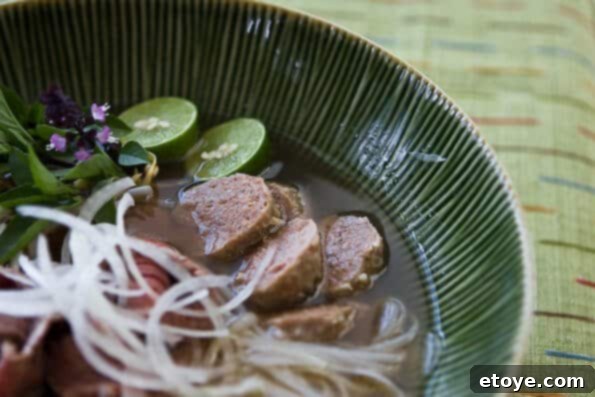
The Night of the Great Pho Experiment: A Lesson in Culinary Humility
My grand overnight Pho experiment, alas, did not unfold as serenely as I had envisioned. Instead of a peaceful night’s rest leading to a perfectly clear, deeply flavored broth, it devolved into a comedy of culinary anxieties:
11:30 PM: The initial hard boil of bones commences, a crucial step to cleanse them of impurities and scum. Simultaneously, I char the ginger and onion, filling the kitchen with promising aromas.
11:38 PM: Water is drained, fresh water added. Cleaned bones, toasted spices, charred ginger, and onion are united. The slow dance of flavor extraction begins.
11:45 PM: Time for bed, anticipating a delicious awakening.
12:35 AM: A sudden jolt of doubt. Is the flame truly low enough? A stealthy trip to the kitchen confirms it’s okay, but sleep’s fragile embrace is broken.
1:23 AM: A peculiar smell wafts through the house. Panic sets in. Another inspection. All clear, but the scent lingers, a phantom of my imagination.
2:41 AM: What if it boils over? The thought is enough to propel me out of bed for another check. The broth is behaving, but my mind is not.
3:24 AM: The paranoia escalates. What if a gas bubble causes the stove to spontaneously burst into flames? Perhaps sleeping on the couch, closer to the kitchen, is a safer bet. The fear is real.
4:45 AM: Hunger strikes, a cruel twist given the hours spent cooking. A secret rendezvous with a generous spoonful of Ben & Jerry’s Pistachio Ice Cream ensues.
4:51 AM: Did I put the ice cream back in the freezer? The gas bubble scenario returns with renewed vigor. The couch plan seems idiotic. Retreat back to the ‘safety’ of my bed.
6:00 AM: Children, relentless and energetic, launch their morning assault, jumping on my belly in a frantic bid to awaken me.
6:15 AM: The verdict: I am utterly and irrevocably PHO-KING TIRED. The dream of effortless Pho broth remains just that – a dream.
The Game Changer: Embracing the Slow Cooker for Perfect Pho
Just a few weeks after my exhausting stovetop ordeal, a beacon of hope emerged. The wonderful team at Crock-Pot® (yes, they are meticulous about their trademarking, and for good reason!) reached out, offering their innovative eLume Crock-Pot® Programmable Slow Cooker with Touch Screen Technology for testing. This sleek appliance, with its modern design and intuitive features, promised to be the answer to my Pho-related woes.
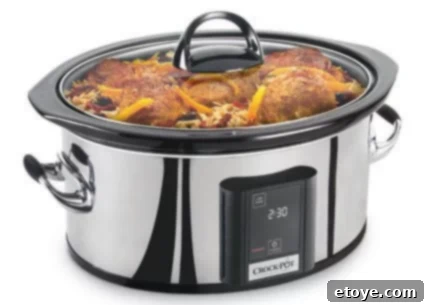
The eLume, with its generous 6.5-quart capacity, was the perfect size for a substantial batch of Pho broth. It immediately addressed my primary concern: the lingering paranoia of leaving a stovetop burner on all night. This device was designed for unattended cooking, bringing peace of mind to the pursuit of authentic flavors.
What truly impressed me about the eLume™ Crock-Pot® was its luminous touchscreen interface. A gentle tap is all it takes to program cooking times, anywhere from a brief 30 minutes to an extensive 20 hours. While it offers a delayed start function, I strongly advise against using it for a Crock Pot Pho recipe due to the raw meat bones involved. For safety and optimal flavor, it’s best to start the cooking process immediately after preparation.
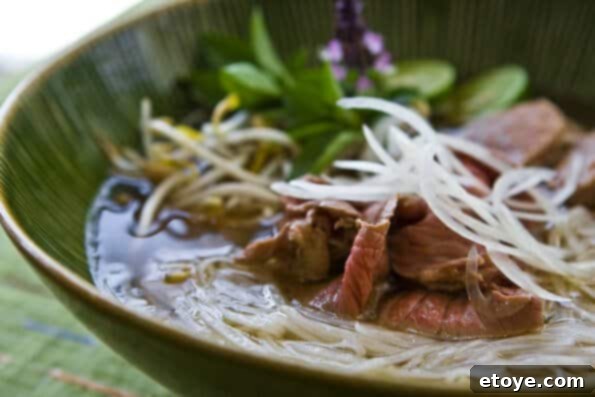
Crafting Exquisite Crock Pot Pho: Step-by-Step Guide
Whether you choose the convenient slow cooker method or the labor-intensive traditional stovetop approach, certain foundational steps are paramount for an outstanding Pho broth. These aren’t just suggestions; they are the secrets to transforming a good Pho into a truly pho-bulous culinary masterpiece. Neglecting these initial preparations will still yield a decent broth, but for that authentic, restaurant-quality depth and clarity, these extra efforts are invaluable.
The Heart of Pho: Toasting Vietnamese Spices
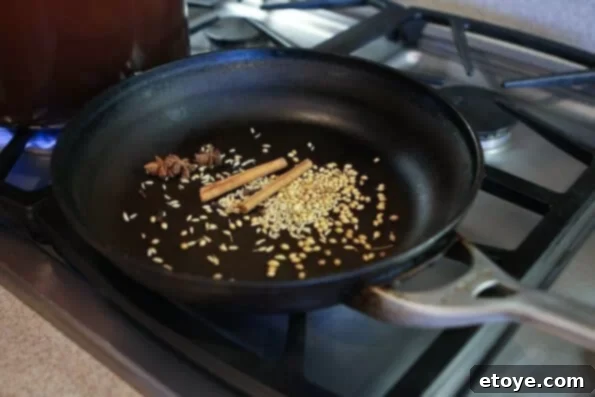
The aromatic soul of Vietnamese Pho resides in its unique blend of spices. These can typically be found at most Asian supermarkets. You have the option to purchase them individually—coriander seeds, cloves, cinnamon sticks, star anise, fennel seeds, and sometimes black cardamom pods—or as a pre-mixed package, which often includes a convenient mesh bag. While pre-mixed packs are incredibly convenient and budget-friendly, especially if you don’t keep a full spice pantry, their quality can sometimes be inconsistent. For the most vibrant flavor, I recommend sourcing individual, fresh spices whenever possible.
During my Crock Pot Pho preparation, I opted for individual spices, though I did not have a cardamom pod on hand. This illustrates an important point: it’s perfectly acceptable if you’re missing one or two spices; your Pho will still be delicious. The key to unlocking their full potential is to gently toast them in a dry skillet over medium-low heat. This process releases their essential oils, intensifying their fragrance and deepening their flavor profile, which will infuse beautifully into your broth.
Enhancing Depth: Grilling Ginger and Onion
This step, though entirely optional, contributes immensely to the nuanced depth and subtle sweetness of the Pho broth. Grilling the ginger and onion mellows their sharpness and imparts a delightful smoky, caramelized flavor that is a hallmark of authentic Pho. When preparing Pho the traditional stovetop way, I often char these aromatics under the broiler. However, for the slow cooker method, aiming for minimal oven use, I found an equally effective stovetop approach.
After toasting your Pho spices, simply return the frying pan to medium-high heat. Add a touch of oil, then place your halved onion and thick ginger slices directly into the pan. Cook them until they develop a beautiful char and soften slightly. This gentle grilling process brings out a profound sweetness and a smoky complexity that will elevate your broth from good to truly exceptional.
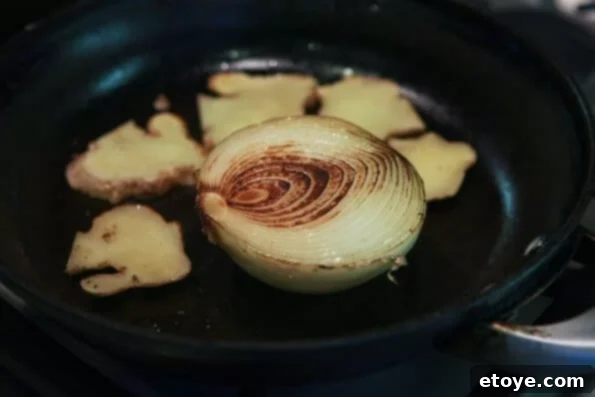
The Foundation of Clarity: Pre-Boiling the Bones
The selection of bones is crucial for a rich and flavorful Pho broth. Beef knuckles, leg bones, and marrow bones are ideal choices as they release collagen and marrow, contributing to the broth’s body and luxurious texture. However, these bones also contain impurities that can cloud the broth and impart an undesirable flavor. This is where the pre-boiling step becomes indispensable.
To begin, bring a large stockpot of water to a vigorous boil over high heat. Add the beef bones and let them boil hard for approximately 10 minutes. During this time, you’ll observe a brownish, scummy foam rising to the surface. This is precisely what we want to eliminate. If you were to skip this pre-boiling, all these impurities would end up in your final broth, compromising its clarity and clean taste.
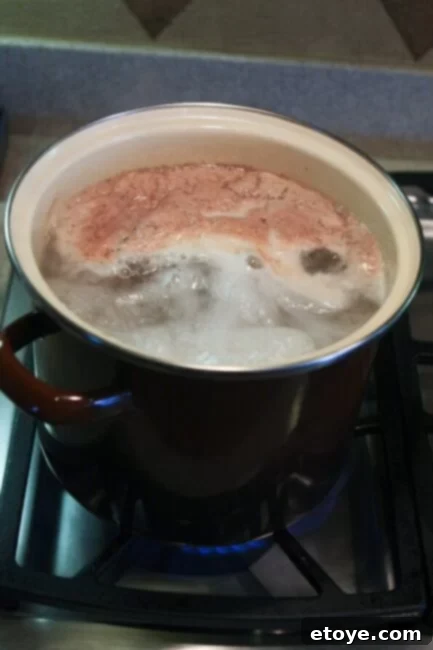
Once the 10 minutes are up, carefully drain the murky water and discard it. Give the bones a quick rinse under cool running water to ensure they are thoroughly clean. This seemingly small step is a cornerstone for achieving that pristine, golden Pho broth coveted by connoisseurs.
With the bones pre-boiled and clean, and your spices toasted and aromatics charred, it’s time for the magic to happen in your slow cooker. Gently transfer the prepared bones, toasted spices, charred ginger, and onion into the slow cooker pot.

Fill the slow cooker with fresh, clean, cool water, leaving about 1 to 1.5 inches of space from the rim to allow for simmering without overflowing. Add the fish sauce and a touch of sugar to begin building the flavor base. Secure the lid, set your slow cooker to the “low” setting, and let it cook undisturbed for a generous 8 hours. While I haven’t experimented extensively with the “high” setting for this recipe, the gentle, prolonged heat of the low setting is ideal for extracting maximum flavor and collagen from the bones without over-reducing the broth or making it cloudy.
This “set it and forget it” method is truly revolutionary for homemade Pho. You can let it simmer all day while you’re at work, or even better, overnight while you enjoy a truly restful sleep. The reward is a remarkably clean, intensely flavorful, and perfectly clear Pho broth. Because the slow cooker maintains a consistent, low temperature, it prevents the hard boiling that can often lead to a murky broth and excessive evaporation on a stovetop. It’s safe, effortless, and yields consistently delicious results.
After 8 hours of slow cooking on low, observe the broth. You’ll notice that the liquid level remains quite high, a testament to the slow cooker’s ability to minimize evaporation compared to a traditional stovetop simmer. Before serving, the rich, golden stock is carefully strained to remove all solids, leaving behind a perfectly clear and aromatic liquid foundation for your Pho.
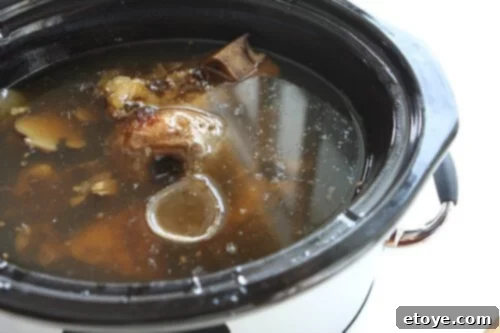
Beyond the Broth: Assembling Your Perfect Pho Bowl
With your magnificent Pho broth ready, it’s time to gather the supporting cast of ingredients that complete this iconic Vietnamese dish. My approach to these components has evolved since my traditional Vietnamese Pho recipe, and I’d like to highlight some preferred choices that enhance the slow cooker Pho experience.
Noodles: Fresh vs. Dried
For unparalleled convenience and texture, I’ve come to favor fresh rice noodles, readily available in the refrigerated section of most Asian markets. Unlike dried noodles, which require a longer soaking and cooking process, fresh rice noodles need only a quick dip in boiling water – literally a couple of minutes – and they’re ready to serve. This significantly speeds up the final assembly of your Pho bowls, making it a truly fast meal.

Proteins: Thinly Sliced Beef and Vietnamese Beef Balls
No Pho is complete without its signature tender beef. For your Pho bowls, select high-quality cuts such as flank steak, London broil, sirloin, or eye of round. The key is to slice the meat as thinly as possible – almost paper-thin. A trick to achieve this is to partially freeze the beef for about 15-20 minutes before slicing. If you have a friendly butcher, a small tip might even convince them to slice it for you on their professional machine, ensuring uniform, delicate slices that will cook instantly when the hot broth is poured over them.
Another delightful addition, and a personal favorite, is Vietnamese beef balls (known as “Bo Vien Dan”). These come frozen in packages at Asian markets and are typically pre-cooked. You’ll find a variety: beef, pork, chicken, fish, crab, and even beef tendon balls, which offer a wonderful chewy texture. To prepare them, simply drop the frozen balls into the same pot of boiling water you used for your noodles. Boil for a few minutes until they are heated through. I recommend slicing the beef balls in half to make them easier to eat and to better absorb the broth’s flavor.

***
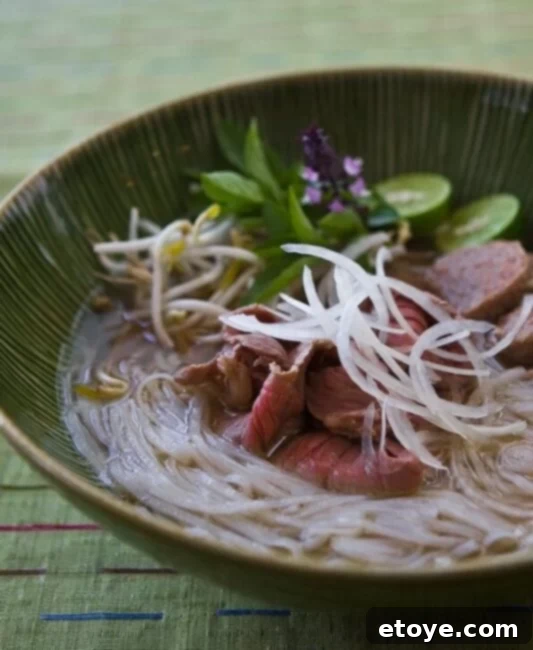
***
Crock Pot Pho Recipe: Effortless Vietnamese Beef Noodle Soup
This recipe is perfectly suited for a 6.5-quart or larger slow cooker. Using a smaller size may not yield enough rich stock due to the generous size of the beef bones. For the thinly sliced beef, partially freezing the cut of meat for about 15 minutes before slicing will make it much easier to achieve those essential paper-thin slices. Don’t hesitate to ask your butcher for assistance; a small tip often works wonders!

Ingredients
For the Pho Stock (Serves 4):
- 4 pounds beef bones (knuckles, marrow bones, leg bones recommended)
- 1/2 large onion, halved
- 4-inch section of ginger, sliced thickly
- 1 package Vietnamese Pho Spices (or individual spices: 2 cinnamon sticks, 2 teaspoons whole coriander seeds, 1 teaspoon fennel seeds, 3 whole star anise, 3 whole cloves, 1 cardamom pod)
- 9 cups water
- 2 1/2 tablespoons fish sauce, or to taste
- 1 teaspoon sugar
For the Pho Bowls:
- 16 ounces fresh or dried rice noodles
- 1/2 pound flank, London broil, sirloin, or eye of round steak, sliced as thinly as possible
- 11 ounces Vietnamese beef balls, cut into halves
For the Table (Garnishes):
- 1-2 limes, cut into wedges
- Fresh herbs: cilantro, Thai basil, mint
- 2-3 chili peppers (e.g., bird’s eye chilies), sliced
- 2 large handfuls of fresh bean sprouts
- Hoisin sauce
- Sriracha hot chili sauce
Instructions
- Prepare the Bones: Bring a large stockpot of water to a rolling boil over high heat. Add the beef bones and boil vigorously for 10 minutes. This essential step cleans the bones and removes impurities, ensuring a clear broth.
- Toast Spices and Char Aromatics: While the bones boil, heat a dry frying pan over medium-low heat. Add the Vietnamese Pho Spices and toast them gently until fragrant, about 2-3 minutes. Immediately transfer the toasted spices to your empty slow cooker. Return the frying pan to medium-high heat, add 1 tablespoon of oil. Once hot, add the sliced ginger and onion half. Cook until the ginger is browned on both sides and the onion is nicely charred and softened. Add these aromatics to the slow cooker with the spices.
- Assemble and Cook the Broth: After pre-boiling, drain the bones, discard the scummy water, and rinse the bones briefly under cool water to thoroughly clean them. Add the cleaned bones to the slow cooker along with the toasted spices, charred ginger, and onion. Fill the slow cooker with fresh, cool water, leaving about 1 to 1.5 inches of space from the rim. Stir in the fish sauce and sugar. Cover and set the slow cooker to cook on the LOW setting for 8 hours. Once cooked, taste the broth and adjust seasoning with additional fish sauce or sugar if desired.
- Prepare Bowl Components: When you are ready to serve, begin preparing the rest of the Pho bowl ingredients. Bring a pot of water to a boil. Add the halved beef balls and cook until heated through, approximately 2 minutes. Remove the beef balls and set aside, keeping the water boiling. Now, cook the rice noodles according to package instructions. If using fresh noodles, they will only need a couple of minutes. Drain the noodles immediately.
- Strain the Broth: Carefully strain the prepared Pho stock through a fine-mesh sieve into a clean pot or large bowl. Discard all the solids (bones, spices, ginger, onion). You are left with a beautifully clear and aromatic broth.
- Serve Your Pho: Arrange 4 large serving bowls on your counter. Evenly distribute the cooked rice noodles, sliced beef balls, and the very thinly sliced raw steak into each bowl. Ladle the piping hot Pho stock over the ingredients in each bowl. The heat from the broth will gently cook the thin slices of steak to perfection. Serve immediately with a platter of lime wedges, fresh herbs (cilantro, Thai basil, mint), sliced chili peppers, bean sprouts, Hoisin sauce, and Sriracha hot chili sauce, allowing everyone to customize their bowl to their liking.
There you have it – an incredibly flavorful and authentic Crock Pot Pho recipe that delivers on taste without the sleepless nights. Enjoy the process and the delicious results!
Vietnamese Pho Recipe (Traditional Stovetop)
Vietnamese Chicken Pho Recipe (Pho Ga)
